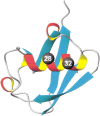Noncharged amino acid residues at the solvent-exposed positions in the middle and at the C terminus of the alpha-helix have the same helical propensity
- PMID: 12761387
- PMCID: PMC2323897
- DOI: 10.1110/ps.0304303
Noncharged amino acid residues at the solvent-exposed positions in the middle and at the C terminus of the alpha-helix have the same helical propensity
Abstract
It was established previously that helical propensities of different amino acid residues in the middle of alpha-helix in peptides and in proteins are very similar. The statistical analysis of the protein helices from the known three-dimensional structures shows no difference in the frequency of noncharged residues in the middle and at the C terminus. Yet, experimental studies show distinctive differences for the helical propensities of noncharged residues in the middle and in the C terminus in model peptides. Is this a general effect, and is it applicable to protein helices or is it specific to the model alanine-based peptides? To answer this question, the effects of substitutions at positions 28 (middle residue) and 32 (C2 position at the C terminus) of the alpha-helix of ubiquitin on the stability of this protein are measured by using differential scanning calorimetry. The two data sets produce similar values for intrinsic helix propensity, leading to a conclusion that noncharged amino acid residues at the solvent-exposed positions in the middle and at the C terminus of the alpha-helix have the same helical propensity. This conclusion is further supported with an excellent correlation between the helix propensity scale obtained for the two positions in ubiquitin with the experimental helix propensity scale established previously and with the statistical distribution of the residues in protein helices.
Figures




Similar articles
-
Hydration of the peptide backbone largely defines the thermodynamic propensity scale of residues at the C' position of the C-capping box of alpha-helices.Proc Natl Acad Sci U S A. 2001 Sep 11;98(19):10670-5. doi: 10.1073/pnas.191381798. Epub 2001 Sep 4. Proc Natl Acad Sci U S A. 2001. PMID: 11535835 Free PMC article.
-
Amino acid propensities for the collagen triple-helix.Biochemistry. 2000 Dec 5;39(48):14960-7. doi: 10.1021/bi001560d. Biochemistry. 2000. PMID: 11101312
-
Structural basis of amino acid alpha helix propensity.Science. 1993 Jun 11;260(5114):1637-40. doi: 10.1126/science.8503008. Science. 1993. PMID: 8503008
-
Positional effects on helical Ala-based peptides.Biochemistry. 2010 Nov 2;49(43):9372-84. doi: 10.1021/bi101156j. Biochemistry. 2010. PMID: 20925317
-
PDBparam: Online Resource for Computing Structural Parameters of Proteins.Bioinform Biol Insights. 2016 Jun 14;10:73-80. doi: 10.4137/BBI.S38423. eCollection 2016. Bioinform Biol Insights. 2016. PMID: 27330281 Free PMC article. Review.
Cited by
-
Enthalpy of helix-coil transition: missing link in rationalizing the thermodynamics of helix-forming propensities of the amino acid residues.Proc Natl Acad Sci U S A. 2005 Feb 1;102(5):1413-8. doi: 10.1073/pnas.0408004102. Epub 2005 Jan 25. Proc Natl Acad Sci U S A. 2005. PMID: 15671166 Free PMC article.
-
Critical Roles for Coiled-Coil Dimers of Butyrophilin 3A1 in the Sensing of Prenyl Pyrophosphates by Human Vγ2Vδ2 T Cells.J Immunol. 2019 Aug 1;203(3):607-626. doi: 10.4049/jimmunol.1801252. Epub 2019 Jun 21. J Immunol. 2019. PMID: 31227581 Free PMC article.
-
Uncovering the Contributions of Charge Regulation to the Stability of Single Alpha Helices.Chemphyschem. 2023 Apr 3;24(7):e202200746. doi: 10.1002/cphc.202200746. Epub 2023 Jan 4. Chemphyschem. 2023. PMID: 36599672 Free PMC article.
-
Conformational dynamics and structural plasticity play critical roles in the ubiquitin recognition of a UIM domain.J Mol Biol. 2010 Mar 5;396(4):1128-44. doi: 10.1016/j.jmb.2009.12.052. Epub 2010 Jan 4. J Mol Biol. 2010. PMID: 20053359 Free PMC article.
References
-
- Aurora, R., Srinivasan, R., and Rose, G.D. 1994. Rules for α-helix termination by glycine. Science 264 1126–1130. - PubMed
-
- Blaber, M., Zhang, X.J., and Matthews, B.W. 1993. Structural basis of amino acid α helix propensity. Science 260 1637–1640. - PubMed
-
- Blaber, M., Zhang, X.J., Lindstrom, J.D., Pepiot, S.D., Baase, W.A., and Matthews, B.W. 1994. Determination of α-helix propensity within the context of a folded protein: Sites 44 and 131 in bacteriophage T4 lysozyme. J. Mol. Biol. 235 600–624. - PubMed
-
- Blagdon, D.E. and Goodman, M. 1975. Mechanisms of protein and polypeptide helix initiation. Biopolymers 14 241–245. - PubMed
Publication types
MeSH terms
Substances
Grants and funding
LinkOut - more resources
Full Text Sources
Other Literature Sources
Miscellaneous

